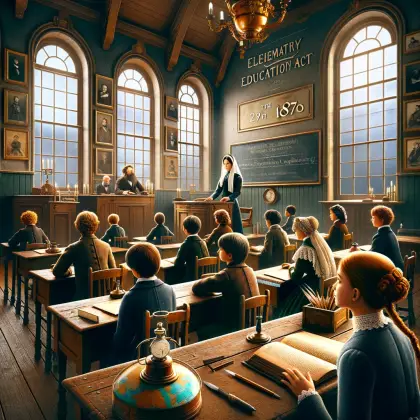The Dawn of Education in England: Ecclesiastical Beginnings
The earliest known schools in England were connected to the Church, dating back to 600 AD. In 604 AD, a school was established in what is now known as Rochester Cathedral. Though things started earlier, it cannot be said that this translated into an education system for all.
The Rise of Independent and Grammar Schools
The tradition of independent schools in England dates back to the 10th century, with Canterbury’s King’s School being the oldest such institution. During the Tudor period, free grammar schools offered education without fees for those unable to afford it. However, this opportunity was not widespread due to the necessity of household labour.
Parliamentary Patronage of Education
Things started to move in the 18th Century when parliament began to invest in building schools for poor children.
This was the state’s first involvement in education (1833). In 1839, Government grants were available for building and maintaining schools, including inspections.
The Grammar School Act of 1840 enriched the curriculum, including science and literature.
During Gladstone’s time as Prime Minister, Robert Lowe (politician) was a key reformer, specifically by looking at raising standards, preventing the waste of money, and highlighting inefficient teaching. From this work a revised code was released in 1861, this changed the funding on grants being dependant on the outcome of student performance in passing exams on reading, writing, and maths. This was known as Payments by results.
The Forster Act and Compulsory Education
This brings us to the headline poster of this blog post. The Forster Act / Elementary Education Act of 1870 required schooling be provided at primary age, in areas where there were inadequate provisions. Section 74 of the act gave powers to school boards to make attendance compulsory between the ages of 5 and 13. The exemptions for children over 10 who had attained the required educational standards (this standard also had variances across the country. The other exception as is the case today, is Illness, a child would be exempt for the duration of that illness.
Reflection on Educational Progress and the Contemporary Landscape
The strides from ecclesiastical instruction to establishing compulsory education reflect a profound transformation in societal values and government responsibility. The Forster Act of 1870, a legislative cornerstone, democratised education and laid the groundwork for the intricate and comprehensive educational system we witness today.
The journey from selective and fee-based learning to a universal right underscores a pivotal societal recognition: education is the backbone of personal development and societal advancement. The evolution from the rudimentary schools of yesteryear to the modern institutions of today mirrors the progression of England itself—a tapestry woven through time, reflecting advancements in pedagogy, inclusivity, and educational equality.
Subsequent years witnessed further reforms, each building on the last to enhance accessibility, quality, and the range of subjects offered. The 20th and 21st centuries have seen the introduction of progressive policies aimed at tailoring education to the needs of a diverse student body, fostering an environment where every child can thrive.
However, the journey is far from complete. Contemporary challenges such as educational disparities, resource allocation, and adapting to the digital revolution confront the system. As we reflect on the past, it becomes evident that education must continue to evolve, mirroring the dynamic society it serves. The quest for a balanced, fair, and future-oriented education system remains at the forefront of policy-making and societal discourse.
In essence, the history of education in England is a chronicle of past achievements and a continuous narrative that shapes the citizens and the nation’s future. It stands as a testament to the enduring belief that education is a fundamental right and an indispensable asset for society’s collective well-being and prosperity.
References:
“The earliest known schools in England were connected to the Church, all the way back to 600 AD.
Things started to move in the 18th Century when parliament began to put money into building schools for poor children.
This was the state’s first involvement in education (1833). 1839 Government grants were available for the construction and maintenance of schools, this included inspections.
During Gladstone’s time as Prime Minister, Robert Lowe (politician) was a key reformer.
This was known as Payments by results.
The Forster Act / Elementary Education Act of 1870 required schooling to be provided at primary age in areas with inadequate provisions. Section 74 of the act gave school boards the power to make attendance compulsory between the ages of 5 and 13.




